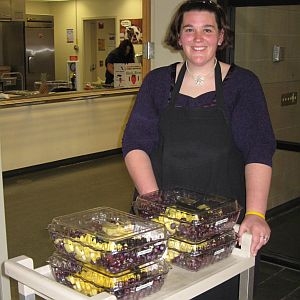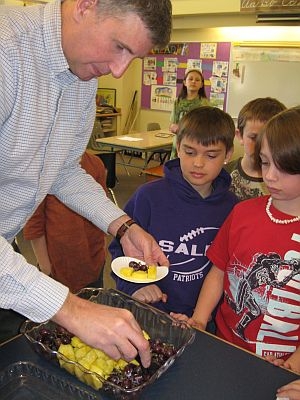
(Host) With childhood obesity a growing epidemic, states and local communities are trying to come up with new and better ways to educate kids about nutrition.
And we’re going to look at the topic in a series of reports this week.
In Vermont, 57 schools have taken over snack time to encourage kids to eat more fruits and vegetables.
As VPR’s Nina Keck reports, school officials and students alike are eating up the new program.
(Burnham) "Friends you have a new one today, a new fruit. You’re getting grapes, but you’re also trying pineapple. Okay?"
(Students) "Yeahhh!!!!!"
(Keck) It’s snack time at Mettawee Community School in West Pawlet, and all eyes are on Brook Burnham as she wheels her food cart from classroom to classroom. The preschoolers, she says, get especially excited.
(Burnham) "Hello friends."
(Students) "Hello."
(Burnham) "I brought your snack down today instead of Mrs. Collard coming to get it. So you have grapes and you have pineapple to try, a new one."
(Student) "I like grapes!"
(Burnham) "You like grapes!"
(Keck) The 190 students at Mettaweee enjoy fresh fruits and vegetables every morning thanks to a $13,000 state education grant funded by the U.S. Department of Agriculture. To qualify, a school has to have a high percentage of low income students. Heather Champney, Mettawee’s kitchen manager, says they couldn’t afford the fruit, or a part-time employee to prepare it, without the funding.
(Champney) "Just for an average for the month of March, we spent $1,300 just on the fruit and vegetables."
(Keck) Champney and fourth-grade teacher Mark Rampone say it’s money well spent, since so many kids don’t get fresh fruits or vegetables at home.
( Rampone) "Now we haven’t had pineapple as one of our snacks, yet. Has anyone here had fresh pineapple? A number of kids – some kids, no, though. Will – you’ve never had fresh pineapple before? Have you had canned? No? So this’ll be a nice thing for you to try."
Rampone) "Now we haven’t had pineapple as one of our snacks, yet. Has anyone here had fresh pineapple? A number of kids – some kids, no, though. Will – you’ve never had fresh pineapple before? Have you had canned? No? So this’ll be a nice thing for you to try."
(Keck) Over the past 30 years, the childhood obesity rate in the United States has doubled for children and tripled for adolescents. Overweight kids are more likely to develop type 2 diabetes, high blood pressure and heart disease. Since 95 percent of young people are enrolled in schools, many experts believe innovative school programs can go a long way to help fight obesity. Mandy Mayer is Mettowee’s nurse and health coordinator.
(Mayer) "We can stand up in front of a class as much as we want and lecture them about healthy eating."
(Keck) But for the kids to really absorb and practice what they learn, Mayer says hands-on modeling is what works best.
(Mayer) "They have to have the fruits and vegetables there every day so they can see this is what we do. They’ll be hungry, they’re ready for it and all together as a class they’ll be sharing in wholesome foods."
(Keck) It’s a lesson 12-year-old Autumn Manning clearly gets.
(Manning) "Yeah, because the choices we make now can affect who we are when we grow up. Like if we get into the habit of eating fresh fruits and veggies now, we’ll be more likely to eat them later on ‘cuz we’re already in the habits.
(Keck) Her classmate, Emily Couper, says it’s also a lesson kids are taking home.
(Couper) "Yesterday me and my mom were at the store and I asked her to get some kiwi ‘cuz that was a fruit that I had here and I really enjoyed it."
(Keck) Officials at the U.S. Department of Agriculture say schools in all 50 states are participating and the response has been overwhelmingly positive.
Because the program has been offered nationally for less than two years, there is little scientific data on its effectiveness.
But officials say anecdotal evidence has pushed the agency to boost funding from $40 million to $150 million annually.
Vermont will see its funding nearly double to $1.2 million – meaning even more schools will be able to take part next year.
For VPR News, I’m Nina Keck in West Pawlet.